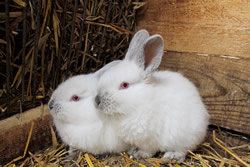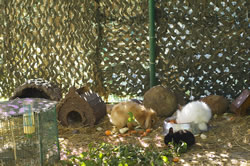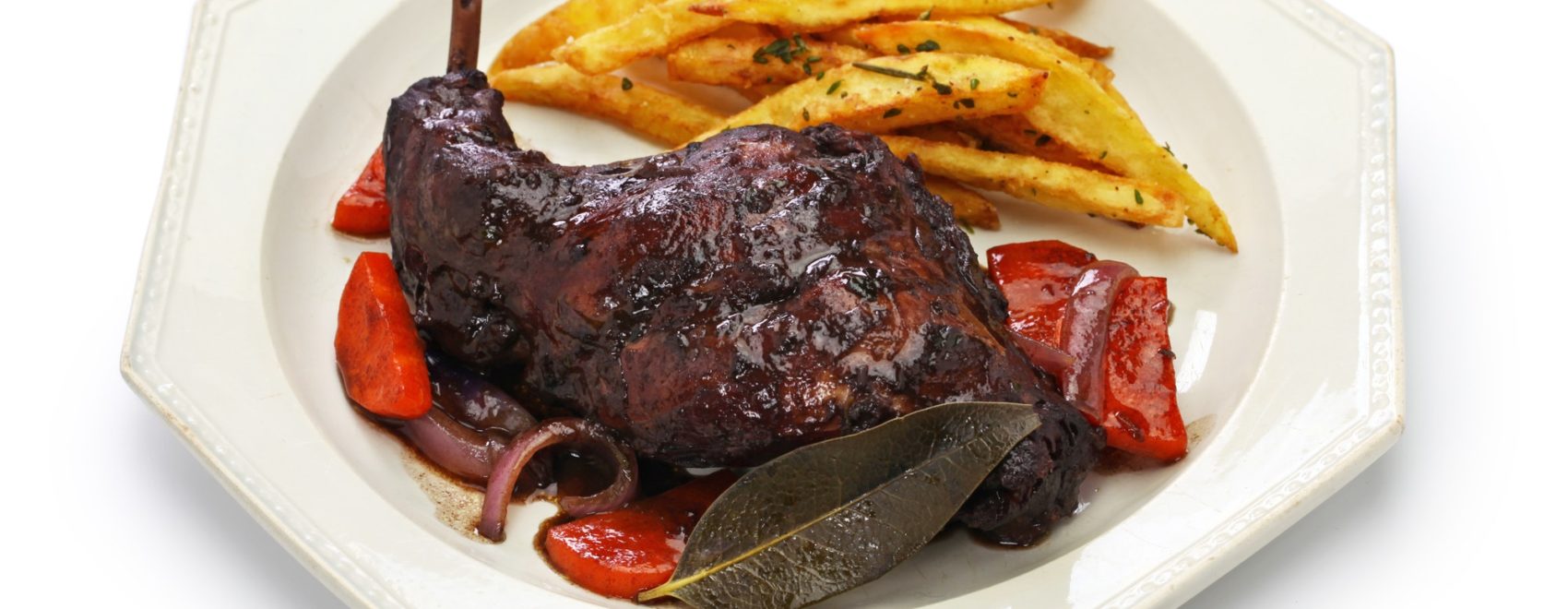The Benefits of Raising Meat Rabbits
Raising meat rabbits is one of the most space efficient means of growing livestock for meat. Whether you live on a full blown many acre homestead, or on a town lot in the burbs, rabbits are a viable option in your self-sufficiency and survival planning.
They are a great source of protein, are relatively easy keepers, and they breed like, well, like rabbits. In addition, raising meat rabbits is a low cost way to provide food for your family year round.
The Best Breeds of Meat Rabbits

You don’t need a large complement of breeders to provide your family with a steady supply of fresh meat. A good California White or New Zealand White, two of the best breeds for meat production, can produce 6 litters per year with 6-10 kits per litter.
Kits (baby rabbits) mature to butchering size in about ten weeks. Based on these numbers, you can see that a relatively small complement of does can provide your family with a great deal of meat, and running a surplus is not out of the question on small scale operations.
How to Get Started Raising Meat Rabbits
So, what are you going to need to get started? First, you need to decide how many does (females) you want to maintain. Bear in mind that 5 does can produce more than 180 kits each year, which is probably a good supply for the average family. In addition to your does you will need a buck (male), for obvious reasons. Once this decision has been made, you will need to get your cages together.
Choosing the Right Cages for Raising Meat Rabbits
Each doe will need its own cage of at least 30” by 30”. Wire floors are best because they allow feces to drop through, providing a cleaner and healthier environment for your rabbits. You can buy ready made cages, or to save some money you can build them from ½ inch hardware cloth or cage wire using a ring crimper and rings to join the pieces.
This is a simple project that doesn’t require any special skills, doesn’t take much time, and requires only the crimper in terms of specialized tools. You can hang the cages directly over compost bins, and rabbit poop can be used as fertilizer straight from the rabbit, it is not hot like chicken manure and will not burn your plants. But I do recommend getting a urine odor eliminator. Hanging cages can also directly feed worm beds if you want to couple these two activities.
Choosing the Best Feeder and Waterer
Each cage will require a feeder and a waterer. These run from simple to elaborate, and can be tailored to meet your budget. Stay away from bowls. Feed bowls waste feed, being easily spilled, and water bowls result in wet rabbits with nothing left to drink.
Small animal water bottles, available at pet and farm supply stores work best and are cheap. Feeders that mount to the side of the cage and open to the outside for filling are also readily available, and a good investment.
Nesting Boxes and Ideal Location for Meat Rabbits

Each doe cage will need a nesting box. Nesting boxes are exactly what they sound like, and they can be homemade or store bought. We have always liked the tin ones from farm supply stores as our rabbits have tended to chew on wooden ones.
Summer heat is one of the big enemies of rabbit raising. When temperatures stay too high, your buck may lose the inclination and ability to do his job. Be sure to locate your cages in a shady spot if they are to be outside.
I have a farmer’s market friend that raises rabbits. At his place they freeze water bottles each night and place a frozen bottle in each cage every morning. This has proven to work well, and they breed year round in outdoor cages. If you choose to raise rabbits in a shed or garage, be certain that it is well ventilated, and even some A/C isn’t a bad idea. Let your space and your budget be your guide when raising meat rabbits.
Breeding Your Meat Rabbits
When it is time for breeding, it is best to put the Buck into the Does cage rather than the other way around. This has to do with territorial behavior, and the ease of handling your buck when it is time for your breeders to part company. Gestation runs right at 31 days, although kits can be born anywhere from 28 to 35 days after breeding. Some degree of record keeping is an extremely wise idea, so you know when to be watching for your kits.
Kits will mature to butchering size in about ten weeks, and don’t need to be with their mother that whole time. You should have cages for your kits so that the mamma rabbit can rotate back into your breeding cycle.
Raising Meat Rabbits: Feeding Options
Feeding provides a lot of options. There are many commercial feeds available. For feed purchase I recommend a feed store over a pet store.
Feed stores sell in bulk, and are generally a lot cheaper than pet stores. You can find a feed that meets your philosophy, if GMO free or Organic are your goals. Bear in mind that these “specialty” feeds will cost you more, but they are worth it if that is what is important to you.
Rabbits can be fed on hay as well, and in a pinch you can give them grasses that you harvest in your surroundings. They are also great for disposing of carrot tops, apple cores, and other vegetable kitchen waste. Sore as much feed as you can manage, just like you prep for yourself.
Butchering Your Rabbits for Meat
Butchering is the most emotionally draining part of any meat production operation. Bunnies are cute, and it can be a hurdle at first to convert them into a food product. Bear in mind that that is their purpose, and strive to give them the best life you can and the most humane death possible.
It is the circle of life, but it need not have any element of cruelty to it. A side note is to never let the kids name any animal destined for the cook pot, things with names are infinitely harder to kill when the time comes!
A sharp blow with a club to the back of the head, as brutal as it may seem, is generally the most humane way to dispatch your meat rabbits. After that it is a simple matter of skinning and gutting. Parting rabbits out for frying is fairly self-explanatory once you see the dressed carcass.
From there your rabbits can be stewed, roasted, or fried in an infinite variety of ways, and are tasty enough to get you over the trauma of butchering in a big hurry!
All in all, raising meat rabbits are a great addition to your self-sufficiency and preparedness program no matter where you live. A bit of infrastructure, a bit of management, and a little cleaning will provide your family with a ready supply of fresh meat and your garden with a ready supply of organic fertilizer.



Put the doe in the bucks cage, not the buck in the does cage. The doe could kill the buck if you put a buck in their cage.
I was going to point out the same thing. Does are way more territorial.
I love rabbit. I was raised on it. The good. COTTONTAIL.
I was enjoying your info, until you said to take the buck to the doe. After 30 years of raising, off and on, I know better.
Is there anything special about the bucks first impregnate and also the does first impregnation?
Are the kids stronger or better for breeding?